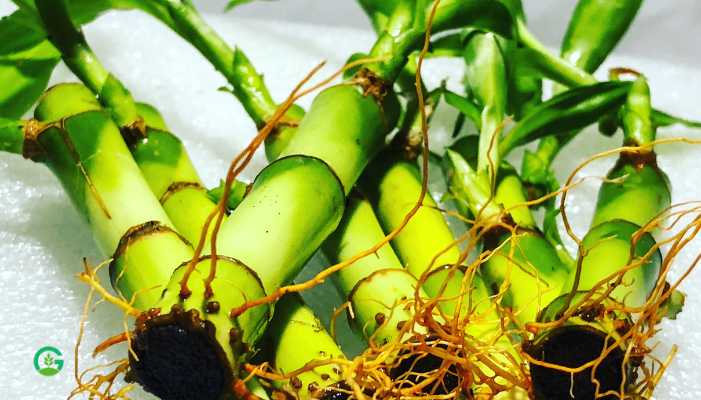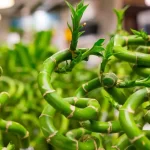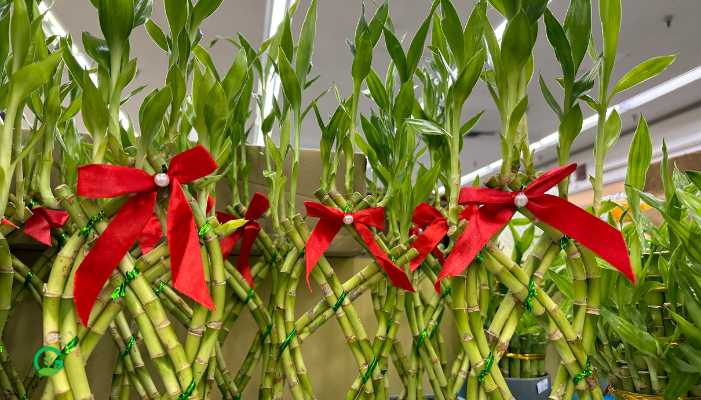Lucky bamboo (Dracaena sanderiana) is a popular houseplant known for its ability to thrive in a variety of conditions and its reputation for bringing good luck and positive energy.
Despite its name, lucky bamboo is not true bamboo but belongs to the Dracaena family. This versatile and resistant plant can be grown in both water and soil, making it a favorite among plant enthusiasts.
This guide will help you understand how to grow and care for your lucky bamboo, ensuring it stays healthy and vibrant.
Lucky Bamboo Plant Table of Contents
What is Lucky Bamboo?
Lucky Bamboo, scientifically known as Dracaena sanderiana, is a resilient plant native to Central Africa. It is often associated with Feng Shui, where it is believed to bring prosperity, luck, and good fortune.
Lucky Bamboo can be shaped into various forms, such as spirals, braided stalks, or simple straight stems, making it a versatile addition to any home or office decor.
Benefits of Growing Lucky Bamboo Plant
- Aesthetic Appeal: Its sleek, green stalks and ability to be shaped into decorative forms make Lucky Bamboo a stylish indoor plant.
- Air Purification: Like other houseplants, Lucky Bamboo can help purify the air by removing toxins.
- Low Maintenance: It requires minimal care, making it ideal for beginners or busy individuals.
- Symbolism: In Feng Shui, it is believed to bring positive energy, luck, and prosperity.

How to Grow Lucky Bamboo Plant
Growing in Water
One of the most popular ways to grow Lucky Bamboo is in water. Here’s how to do it:
- Choose the Right Container: Select a container that is wide and deep enough to support the stalks. Glass containers are popular as they allow you to see the roots and water level.
- Add Pebbles: Place pebbles or marbles at the bottom of the container. These will help support the stalks and keep them upright.
- Add Water: Fill the container with distilled or filtered water. Tap water can contain chlorine and other chemicals that might harm the plant. If you must use tap water, let it sit for 24 hours to allow the chlorine to dissipate.
- Insert the Stalks: Place the Lucky Bamboo stalks into the container, ensuring the roots are submerged in water. Arrange the stalks as desired.
- Maintain Water Level: Ensure that the roots are always submerged in water. Change the water every two to four weeks to prevent stagnation and algae growth.
Growing in Soil
Lucky Bamboo can also be grown in soil, which provides a more stable environment for the plant.
- Choose a Pot: Select a pot with drainage holes to prevent waterlogging.
- Use Well-Draining Soil: Fill the pot with a well-draining potting mix, ideally one designed for houseplants.
- Plant the Stalks: Place the Lucky Bamboo stalks into the soil, ensuring that the roots are well-covered.
- Water Properly: Water the plant thoroughly, ensuring the soil is evenly moist but not waterlogged. Allow the top inch of soil to dry out between waterings.
- Provide Adequate Light: Place the pot in a location with bright, indirect light.

Caring for Lucky Bamboo Plant
Light Requirements
Lucky Bamboo thrives in bright, indirect light. Direct sunlight can scorch the leaves, so it’s best to place the plant in a spot with filtered light. If grown in low light conditions, the plant may grow slowly and become leggy.
Watering
- In Water: Ensure the roots are always submerged in water. Change the water every two to four weeks.
- In Soil: Water the plant thoroughly, allowing the top inch of soil to dry out between waterings. Overwatering can lead to root rot.
Temperature and Humidity
Lucky Bamboo prefers temperatures between 65°F and 90°F (18°C to 32°C). It can tolerate normal indoor humidity levels but thrives in slightly humid conditions. Avoid placing the plant near drafts, air conditioners, or heating vents.
Fertilizing
Lucky Bamboo does not require much fertilization. If you choose to fertilize, use a diluted houseplant fertilizer every two to three months. Over-fertilizing can damage the plant, so it’s better to under-fertilize than overdo it.
Pruning and Shaping
Pruning is essential to maintain the desired shape and size of your Lucky Bamboo. Use sterilized scissors or pruning shears to trim any yellow or overgrown leaves. You can also cut the stalks to control the plant’s height. If you want to shape the plant, use wire or other supports to guide its growth.
Pests and Diseases
Lucky Bamboo is relatively resistant to pests and diseases. However, it can occasionally suffer from:
- Spider Mites: These tiny pests can cause yellowing leaves. Wipe the leaves with a damp cloth to remove them or use an insecticidal soap.
- Root Rot: Overwatering or stagnant water can lead to root rot. Ensure proper drainage and change the water regularly.
- Yellow Leaves: This can be caused by overexposure to sunlight, over-fertilization, or poor water quality. Adjust the plant’s environment accordingly.
Image | Product Name | Review | Price |
Common Problems and Solutions
- Yellowing Leaves: Often a sign of too much sunlight, over-fertilization, or poor water quality. Move the plant to a shadier spot, reduce fertilization, and use distilled water.
- Brown Tips: Indicate low humidity or fluoride in the water. Increase humidity and switch to distilled water.
- Slow Growth: May be due to insufficient light. Move the plant to a brighter location with indirect light.
How to Propagate Lucky Bamboo Plant
Propagating Lucky Bamboo is a simple process and can be done using cuttings:
- Select a Healthy Stalk: Choose a healthy stalk with several nodes (the joints where leaves grow).
- Cut Below a Node: Using sterilized scissors, cut the stalk just below a node.
- Place in Water: Place the cutting in a container of distilled water, ensuring the nodes are submerged.
- Wait for Roots: Within a few weeks, roots should start to develop. Once the roots are a few inches long, you can transfer the cutting to soil or continue growing it in water.
Read More
Feng Shui and Lucky Bamboo Plant
In Feng Shui, the number of stalks in your Lucky Bamboo arrangement holds significance:
- Two Stalks: Love and marriage.
- Three Stalks: Happiness, wealth, and long life.
- Five Stalks: Health.
- Six Stalks: Wealth.
- Eight Stalks: Growth.
- Nine Stalks: Good fortune.
- Ten Stalks: Completion.
- Twenty-One Stalks: Powerful blessings.
Placing Lucky Bamboo in the correct area of your home or office can enhance its positive effects. For example, placing it in the wealth corner (southeast) can attract financial prosperity.
Lucky Bamboo Plant FAQ
How often should I water my Lucky Bamboo?

If growing in water, ensure the roots are always submerged and change the water every two to four weeks. If growing in soil, water thoroughly and let the top inch of soil dry out between waterings.
Can Lucky Bamboo grow in low light?

Yes, Lucky Bamboo can tolerate low light conditions, but it will grow more slowly. For optimal growth, place it in bright, indirect light.
Why are the leaves of my Lucky Bamboo turning yellow?

Yellow leaves can result from overexposure to sunlight, over-fertilization, or poor water quality. Adjust the plant’s environment by providing filtered light, reducing fertilization, and using distilled water.
How do I propagate Lucky Bamboo?

To propagate, cut a healthy stalk below a node and place the cutting in water. Roots should develop within a few weeks, after which the cutting can be planted in soil or kept in water.
Can I trim my Lucky Bamboo?

Yes, you can trim Lucky Bamboo to maintain its shape and size. Use sterilized scissors to cut yellow leaves or overgrown stalks. You can also shape the plant using wire or other supports.
What should I do if my Lucky Bamboo has root rot?

If you suspect root rot, remove the plant from its container and inspect the roots. Trim any black, mushy roots with sterilized scissors. If growing in water, clean the container and replace the water. If growing in soil, ensure the pot has proper drainage and reduce watering.
Is Lucky Bamboo safe for pets?

Lucky Bamboo contains saponins, which can be toxic to pets if ingested. Keep the plant out of reach of pets to prevent any potential harm.
How can I increase the humidity for my Lucky Bamboo?

You can increase humidity by misting the plant regularly, placing a humidifier nearby, or setting the plant on a tray filled with pebbles and water.
Can I use tap water for my Lucky Bamboo?

Tap water can contain chlorine and fluoride, which can harm the plant. It’s best to use distilled or filtered water. If using tap water, let it sit for 24 hours to allow the chlorine to evaporate.
Why is my Lucky Bamboo not growing?

Slow growth can result from insufficient light, poor water quality, or lack of nutrients. Ensure the plant is in bright, indirect light, use distilled water, and consider a diluted houseplant fertilizer every two to three months.
Conclusion
Lucky bamboo is a versatile and low-maintenance plant that can add a touch of beauty and positive energy to any space.
By following these simple guidelines for growing and caring for lucky bamboo, you can ensure that your plant remains healthy and vibrant. Whether you choose to grow it in water or soil, this resilient plant is sure to bring a sense of peace and beauty to your home or office.
Remember, the key to a thriving lucky bamboo is to provide the right balance of light, water, and care.





















1 thought on “How to Grow and Care for Lucky Bamboo Plant”